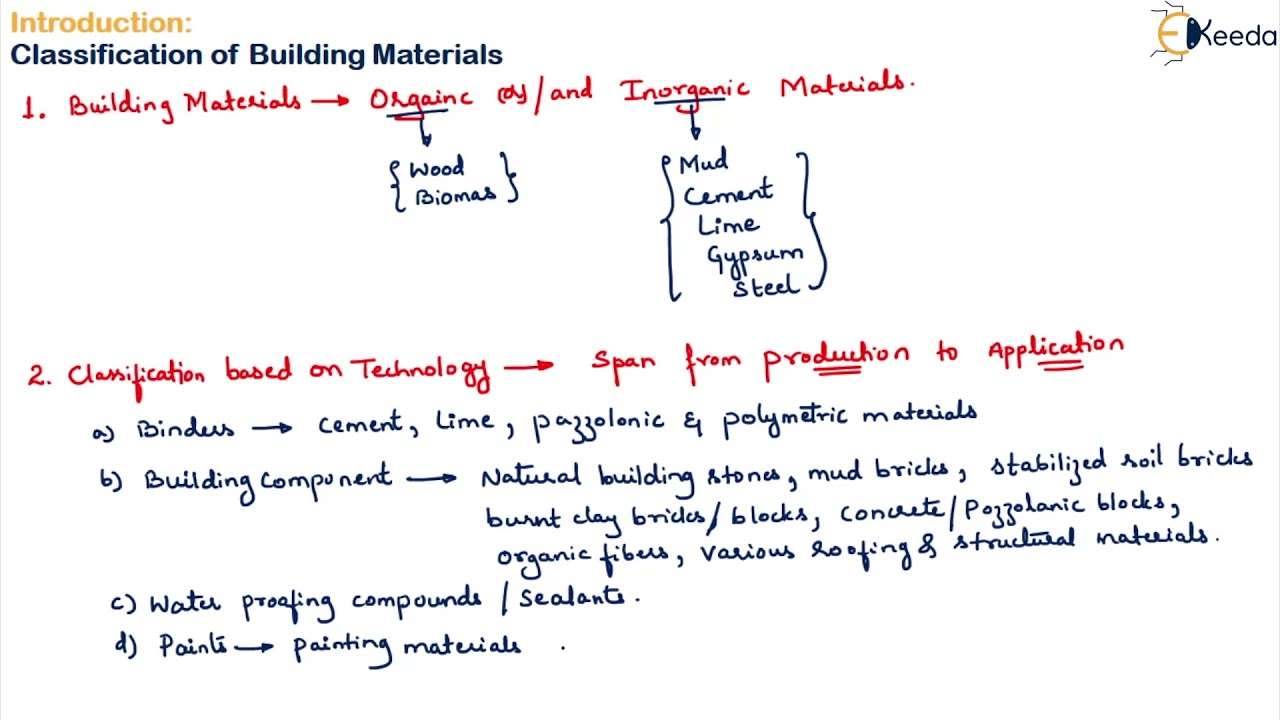The world of construction relies heavily on a vast array of materials, each possessing unique characteristics and suitability for specific applications. Understanding the **classification of building materials** is paramount for architects, engineers, and builders to make informed decisions regarding structural integrity, aesthetic appeal, and overall project success. From the humble brick to advanced composites, a comprehensive grasp of these materials ensures efficient resource allocation and construction practices. The **classification of building materials** allows us to categorize and analyze their properties, leading to optimized design and construction processes. This categorization aids in selecting the most appropriate material for a given task, considering factors such as strength, durability, cost, and environmental impact.
Primary Categories of Building Materials
Building materials can be broadly classified into several primary categories, each encompassing a wide range of specific materials with shared characteristics. These categories provide a foundational framework for understanding the diverse landscape of construction materials.
- Metals: Steel, aluminum, copper, and iron are all widely used metals in construction, offering strength, durability, and versatility.
- Wood: A renewable resource, wood is employed in framing, sheathing, and finishes, valued for its natural beauty and workability.
- Concrete: A composite material made from cement, aggregates, and water, concrete is a cornerstone of modern construction, providing strength and stability.
- Masonry: Brick, stone, and block are masonry materials used for walls, foundations, and paving, offering durability and aesthetic appeal.
- Plastics: Synthetic polymers offer a range of properties, including lightweight, weather resistance, and insulation, making them suitable for various applications.
Sub-Classifications Based on Material Properties
Within each primary category, materials can be further sub-classified based on specific properties, such as strength, density, thermal conductivity, and fire resistance. This granular level of classification allows for more precise material selection.
Strength and Durability
- High-Strength Steel: Used in structural applications requiring exceptional load-bearing capacity.
- Reinforced Concrete: Concrete incorporating steel reinforcement to enhance its tensile strength.
- Hardwoods: Dense and durable woods suitable for flooring and furniture.
Thermal Properties
- Insulation Materials: Fiberglass, foam, and cellulose are used to reduce heat transfer and improve energy efficiency.
- Reflective Materials: Materials that reflect solar radiation to reduce heat gain in buildings.
Comparison of Common Building Materials
| Material | Strength | Durability | Cost | Sustainability |
|---|---|---|---|---|
| Steel | High | High | Moderate to High | Recyclable |
| Wood | Moderate | Moderate | Moderate | Renewable |
| Concrete | High | High | Low to Moderate | Can be sustainable with proper mix design |
Ultimately, the effective use of construction resources hinges upon a keen awareness of the various options available. The nuanced understanding of the **classification of building materials** allows professionals to build safer, more efficient, and more sustainable structures for the future.
Beyond these core classifications, the construction industry continues to evolve, introducing innovative materials and techniques. Composites, for instance, blend different materials to achieve enhanced properties not found in individual components. Think of fiber-reinforced polymers used in cladding or lightweight concrete with improved insulation. These advancements blur the lines between traditional categories, necessitating a more nuanced understanding of material science.
EMERGING TRENDS IN BUILDING MATERIALS
Sustainability is a driving force in the development of new building materials. The industry is actively seeking alternatives to traditional materials with high embodied energy and significant environmental impact. This has led to the exploration of bio-based materials, recycled content, and innovative manufacturing processes.
– Bio-Based Materials: Hempcrete, bamboo, and straw bales are gaining popularity as sustainable alternatives to conventional building materials.
– Recycled Materials: Reclaimed wood, recycled plastic lumber, and crushed concrete are being used to reduce waste and conserve resources.
– 3D-Printed Materials: The rise of 3D printing opens doors to creating customized building components with minimal waste.
THE FUTURE OF BUILDING MATERIAL CLASSIFICATION
As the construction industry embraces technological advancements and sustainable practices, the current classification systems may need to adapt. A more holistic approach that considers the entire lifecycle of a material, from extraction to disposal, may be necessary. This would involve incorporating factors like embodied carbon, recyclability, and environmental impact into the classification process. Imagine a future where building materials are categorized not just by their physical properties, but also by their environmental footprint.
The selection of suitable building materials is influenced by a complex interplay of factors, including project budget, design requirements, local climate, and environmental considerations. A thorough understanding of material properties, coupled with a commitment to sustainable practices, is essential for creating durable, efficient, and environmentally responsible buildings.


